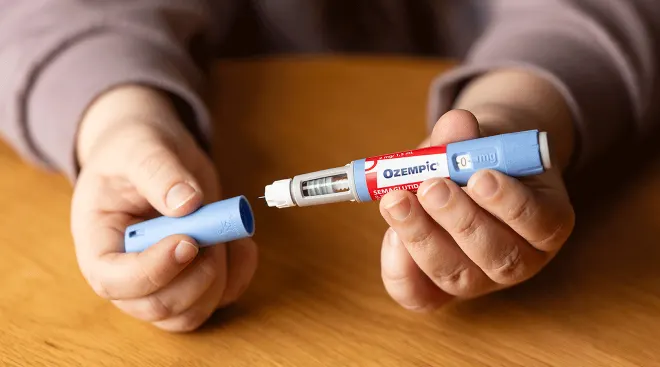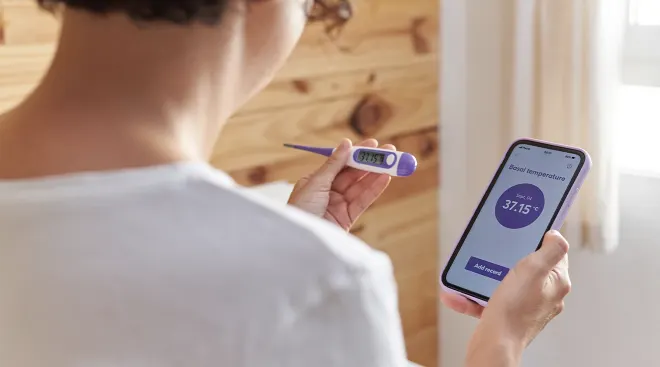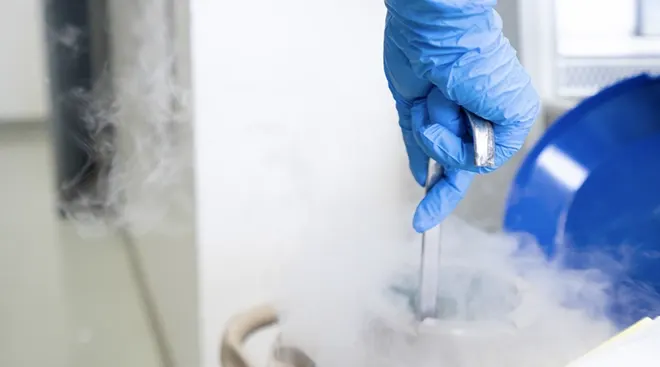How to Check Your Cervical Mucus to See if You’re Ovulating
You’ve probably been told at one point or another to “listen to your body”—and the advice applies to instances beyond just intense workouts. Your body offers all sorts of clues about what’s going on inside, including whether or not you’re ovulating. Changes in your cervical mucus can be a useful indicator to keep track of if you’re trying to get pregnant (or just prefer natural birth control). So what are the types of cervical mucus, what do they signal about where you are in your cycle and how can you check your mucus? Here’s what you need to know.
Cervical mucus is a gel-like mixture secreted by glands found in and around the cervix, explains Shieva Ghofrany, MD, a partner at Coastal Obstetrics & Gynecology in Stamford, Connecticut, and co-founder of Tribe called V. (If you want to get specific, it consists of 90 to 95 percent water and a mix of mucin glycoproteins.) This cervical mucus changes in consistency and color throughout a woman’s menstrual cycle in response to the rise and fall of hormones.
There are four types of cervical mucus that help track the stages of ovulation and fertility, explains Pat Alagia, MD, a board-certified ob-gyn and senior medical director for advanced diagnostics and women’s health at Quest Diagnostics.
• Type 1: This type of cervical mucus occurs immediately after your period and “is when you produce the least amount of cervical mucus,” Alagia says. “You might feel dry and not have any discharge at all.”
• Type 2: It appears about one week after your period, and is “a thin discharge with a light, white color,” Alagia says.
• Type 3: A thicker discharge, this type of cervical mucus has a creamy appearance that feels “sticky or tacky between your fingers,” Alagia says. Type 3 is associated with high fertility.
• Type 4: This is when your body produces the most cervical mucus as it prepares for ovulation. “It appears clear and has a stretchy consistency similar to raw egg whites, known as EWCM (egg white cervical mucus),” Alagia says.
There’s a reason for every change in your cervical mucus throughout your cycle (Mother Nature is so smart!). The mucus can surround and suspend any sperm that enters the vagina, helping it survive for longer in the acidic vaginal environment. (It’s because of this that your fertile window is six days—far longer than just the 12 to 24 hours that an egg can be fertilized.) As you approach ovulation, your cervical mucus becomes creamy, allowing sperm to start to swim through it more easily. During ovulation, the wet, stretchy, egg-white cervical mucus is the easiest type to swim through (while still filtering out the slower swimmers with potential abnormalities). After ovulation, when your fertile window has closed, cervical mucus becomes dry and sparse, making it hard for sperm to swim past the cervix.
Here’s a more thorough breakdown of how your cervical mucus changes during the different stages of your cycle, including after implantation and throughout pregnancy:
Cervical mucus before your period
Expect to see white or yellowish discharge before your period arrives, Alagia says. During this stage of your menstrual cycle (known as the luteal phase), the hormone progesterone is peaking in your body, which increases the production of cervical fluid.
Cervical mucus during your period
During this stage, menstrual blood mixes with cervical mucus, so “it’s hard to differentiate the fluids during menstruation,” Ghofrany says.
Cervical mucus after your period
After menstruation, most women won’t notice any cervical fluid for a couple of days. “This is because your estrogen levels are low and beginning to rise again,” Alagia says. These are known as “dry days.”
Cervical mucus during ovulation
Because of the changes that occur from rising estrogen levels, your cervical mucus will become clear and stretchy. “Egg white cervical mucus resembles clear egg whites and is slippery immediately before ovulation, then becomes tackier,” Ghofrany says. This allows the sperm to penetrate the mucus more easily, after which it will enter the uterine cavity to meet the egg and fertilize it.
Cervical mucus after implantation
After ovulation, if you didn’t become pregnant, your cervical mucus will turn cloudy and sticky again until you re-enter the “dry days,” and then your cycle repeats. However, if an embryo successfully implanted into the sidewall of your uterus, cervical mucus after conception will be thick and clear, according to Ghofrany. You may also experience a small amount of spotting, known as implantation bleeding.
Cervical mucus during pregnancy
Just as your cervical mucus changes throughout the menstrual cycle, it also changes during pregnancy. “It’s usually thin, stickier and milky white, or colorless, and with a mild odor or no odor,” Alagia says. This is referred to as leukorrhea, he explains, and during your first trimester of pregnancy, this vaginal discharge increases in an effort to remove dead cells and bacteria from the uterus and vagina to help prevent infections. “The amount of discharge you experience increases gradually as pregnancy progresses,” he adds. “As long as it remains generally colorless and odorless, it’s normal and not cause for concern.”
The cervical mucus method involves checking the characteristics of your cervical mucus in order to figure out when you’re ovulating and therefore most fertile. From there, you can plan when to have sex to increase your changes of pregnancy (or avoid unprotected sex if a baby isn’t in your plans). You’re essentially keeping a lookout for Type 4 cervical mucus, “when it’s stretchy/elastic and egg white-like in color,” Ghofrany explains. “This consistency is most likely associated with ovulation.”
Keep in mind, though, that the cervical mucus method isn’t viewed as a highly reliable form of birth control. According to the Mayo Clinic, as many as 23 out of 100 women using the cervical mucus method as birth control will get pregnant in the first year of typical use—in other words, it’s estimated to be about 77 percent effective. (With “perfect use,” the pregnancy rate may be as low as 3 out of 100 women a year.)
Checking your cervical mucus is a fairly simple procedure. The best time to check is in a private setting, especially when you’re not sexually aroused. Why? The urethra can expel fluid during masturbation and sex—and you don’t want to mistake it for cervical mucus. You’ll also want to avoid checking your cervical mucus after intercourse, as it can be confused with semen. Ready? Here’s how to check your cervical mucus, step by step:
• Step 1: Start by washing your hands with antibacterial soap and drying them completely with a clean towel.
• Step 2: Find a comfortable position that works for you. This can be squatting, sitting on a toilet or standing and putting one leg up on the edge of the bathtub.
• Step 3: Insert your index finger or middle finger into your vagina to get a sample of mucus from as close to your cervix as possible.
• Step 4: Observe the consistency of the mucus sample. Roll it between your thumb and index finger, then slowly pull your fingers apart to determine if it’s dry and sticky (likely not fertile), creamy (may be approaching ovulation) or wet, stretchy egg-white cervical mucus (fertile).
If you spot any abnormal changes to your cervical mucus, let your doctor know, as they could be symptoms of an infection. According to Alagia and other experts, you should keep a lookout for:
- Green, brown or yellow cervical mucus
- Thick, cottage cheese-like consistency
- A fishy, metallic or otherwise foul odor
- Itching or burning
If you have any concerns, never hesitate to call your doctor.
About the experts:
Shieva Ghofrany, MD, FACOG, is a partner at Coastal Obstetrics & Gynecology in Stamford, Connecticut, and co-founder of Tribe called V, a community where women can learn more about pregnancy and gynecology. Ghofrany earned her medical degree from Sackler Faculty of Medicine, Tel Aviv University in Israel, and in 2016 completed training in integrative health and healing at The Graduate Institute in Bethany, Connecticut.
Pat Alagia, MD, a board-certified ob-gyn and senior medical director for advanced diagnostics and women’s health at Quest Diagnostics. He earned his medical degree from Georgetown University.
Please note: The Bump and the materials and information it contains are not intended to, and do not constitute, medical or other health advice or diagnosis and should not be used as such. You should always consult with a qualified physician or health professional about your specific circumstances.
Plus, more from The Bump:
Navigate forward to interact with the calendar and select a date. Press the question mark key to get the keyboard shortcuts for changing dates.




















































